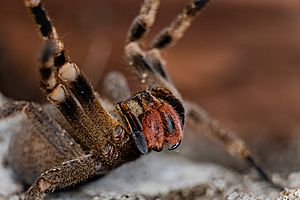Phoneutria nigriventer facts for kids
Quick facts for kids Phoneutria nigriventer |
|
|---|---|
 |
|
| Scientific classification |
The Phoneutria nigriventer is a type of spider that can cause serious bites. It belongs to the Ctenidae family. You can find this spider in parts of South America, including Brazil, Uruguay, Paraguay, and Argentina. People often call these spiders Brazilian wandering spiders because they don't stay in one place.
If this spider bites someone, it can cause strong pain and make their heart beat faster. In some rare cases, a bite can be very dangerous.
Contents
About the Brazilian Wandering Spider
The Phoneutria nigriventer is a big spider. Its body can be about 5 centimeters long. Its legs can spread out to about 15 centimeters on larger spiders. Its body is covered with thick brown hair.
These spiders are active at night. They hunt for food by ambushing their prey instead of building a web. During the day, they hide under logs or in small cracks. If they feel threatened, they will lift their front two pairs of legs as a warning. You can also find them in banana trees, plants, and even inside homes in cities.
Life Cycle
Like most spiders, the female Phoneutria nigriventer is bigger than the male. When they mate, the male spider performs a dance to get the female's attention. Sometimes, male spiders even fight each other. After mating, the female might attack the male.
A female spider can lay around 1,000 eggs. She keeps these eggs safe in a silk sac. Some studies suggest that female spiders carrying egg sacs might have slightly stronger venom.
Venom and What They Eat
The bite of the P. nigriventer spider can make humans feel very sick. Symptoms can include a fast heartbeat, breathing problems, and strong pain. Sometimes, the spider might give a "dry bite," which means it doesn't inject venom. Or it might inject only a very small amount.
The venom of P. nigriventer contains special substances called neurotoxins. These neurotoxins can affect how nerves and muscles work. At high levels, these toxins can cause a person to lose muscle control and have trouble breathing. This can lead to paralysis and make it hard to breathe.
The venom also causes intense pain and swelling where the bite happened. This is because the venom makes certain nerves release chemicals that cause pain and inflammation.
Scientists have studied the venom and found that female spiders usually produce more venom than males. Humans and monkeys seem to react very strongly to this spider's venom.
The Brazilian wandering spider eats many different animals. These include crickets, katydids, and mantids. They also hunt larger animals like tree frogs, lizards, and even bats.
On average, the spider produces about 1.25 milligrams of venom. In the winter, it produces less, around 0.4 milligrams.
Real-Life Bite Stories
Here are a couple of stories about people who were bitten by this spider:
A 23-year-old worker in Brazil was bitten on his hand while moving bananas. The spider was about 3.5 centimeters long, and its legs spread to 6 centimeters. The bite caused extreme pain, sweating, and his hair stood on end. He also felt pain spreading to his chest, his heart raced, and he felt dizzy and sick. He received medicine for pain, a tetanus shot, and antivenom. He felt better after 36 hours.
Another time, a 52-year-old man was bitten by an adult female spider. Right after the bite, he felt severe pain, his vision blurred, and he sweated a lot. He also vomited. A few hours later, he became restless and had high blood pressure. His heart rate went up to 150 beats per minute, and he had cold hands and feet, sweating, and shaking. He was treated with pain medicine, antivenom, and fluids.
Between 1925 and 1945, there were 415 reported bites from this spider. Out of these, 400 people needed antivenom to help them recover.
See also
 In Spanish: Araña bananera para niños
In Spanish: Araña bananera para niños

